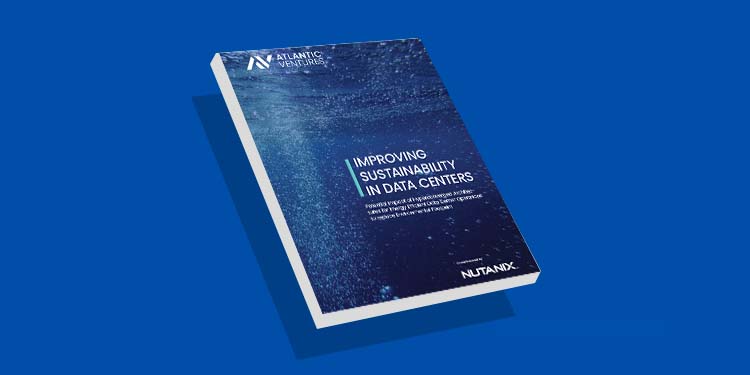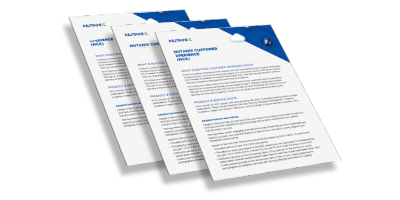What Is a Digital Carbon Footprint & How Can You Reduce Yours?
Historically, IT decisions have been driven primarily by cost and workload placement considerations. This is no longer the case, as the world faces potentially catastrophic climate change.
Sustainability and climate protection are now strategic business imperatives and will play a significant role in corporate governance over the next several decades. Consequently, C-level leaders must realign their companies’ goals to achieve carbon neutrality and reduce global warming.
What is a digital carbon footprint?
A digital carbon footprint is defined as the amount of CO2 emissions that result from producing, using, and transferring data on digital devices and infrastructure. That includes all smartphones, laptops, tablets, every server in every data centre, and much more.
Everything we do online or on our digital devices is part of that footprint, or impact, on the environment. According to Capgemini:
“Every minute spent scrolling a newsfeed, browsing the internet, streaming a video all contribute to our digital carbon footprint. Global email usage generates as much CO2 as having 7 million extra cars on the road. If each email user in the UK sent 1 less email per day, we could reduce emissions by 16,433 tonnes of CO2; the equivalent of 81,152 flights from London to Madrid.”
It’s not just electricity usage that matters, either. Data centre water usage is a concern, and organisations are looking for smart ways to reduce both power and water consumption. They also need ways to reduce e-waste, which consists of electronic devices and other hardware, which contain toxic chemicals and hazardous materials that can leach into groundwater and soil.
Internet pollution and carbon emissions from data centres must be reduced because the carbon footprint of digital technologies, if left unchecked, could lead to serious environmental challenges.
How can you reduce your carbon footprint?
To reduce the carbon footprint created in cloud computing, you can consider implementing the following strategies:
Select energy-efficient data centres:
Choose cloud service providers that operate energy-efficient data centres and have a commitment to sustainability.
Look for providers that use renewable energy sources to power their data centres.
Optimize resource utilisation:
Implement load balancing and auto-scaling techniques to optimise resource allocation and reduce energy consumption during periods of low demand.
Use virtual machine (VM) and container management systems to maximise resource utilisation and minimise idle server time.
Think about data centre location:
Consider the geographic location of the data centres used by your cloud service provider.
Choose providers with data centres located in regions where renewable energy sources are prevalent or where the electricity grid has a lower carbon intensity.
Consolidate and right-size instances:
Consolidate workloads and applications onto fewer instances to reduce the overall number of servers needed.
Right-size instances by adjusting their capacity to match workload requirements, avoiding overprovisioning and wasting resources.
Implement server virtualisation:
Utilise server virtualisation technologies to consolidate physical servers, reducing the number of servers needed to run workloads.
Virtualisation enables better utilisation of server resources and can lead to energy savings.
Keep data storage and management efficient:
Implement data deduplication and compression techniques to reduce storage needs and minimise the energy consumption associated with data storage.
Utilise efficient data management practices, such as tiered storage and data lifecycle management, to optimise storage usage.
Use serverless computing:
Explore serverless computing options offered by cloud service providers.
With serverless architectures, the cloud provider manages the underlying infrastructure, enabling better resource utilisation and reducing energy consumption.
Monitor and optimise energy usage:
Implement monitoring and management tools to track energy usage and identify areas for optimisation.
Use power management features provided by the cloud infrastructure to dynamically adjust resource allocation based on demand.
Encourage sustainable practices:
Work with your cloud service provider to promote sustainable practices within their data centres.
Encourage them to invest in renewable energy sources, improve energy efficiency, and reduce their overall carbon footprint.
Regularly assess and optimise:
Continuously evaluate your cloud computing setup and identify opportunities for improvement.
Stay up-to-date with advancements in cloud technology that promote energy efficiency and sustainability.
The environmental impact of computing
While computers have revolutionised practically every aspect of life and business in extremely positive ways, those benefits come with a cost. In 2021, experts estimated there were about 7.2 million data centres across the globe, all working continuously to meet the intensive computing needs of businesses and enable such operations as data storage, backup, networking, email, website hosting, and more.
Because of their large numbers, the amount of power data centres consume is a serious issue. Data centres vary in size, but many are massive, with thousands—or even tens of thousands—of servers, hungrily consuming electricity. The International Energy Agency estimates that the world’s data centres use about 200 terawatt-hours (TWh) of electricity, which makes up nearly 1% of global electricity demand.
With data centre energy costs on the rise and industry regulations increasing rapidly to address environmental issues, organisations are tasked with finding greener ways to operate. Cloud storage, which relies on enormous data centres managed by hyperscalers, is having a significant environmental impact. Cloud sustainability today relies on the industry developing more energy-efficient operating methods.
What is corporate digital responsibility?
Corporate digital responsibility is a growing movement among tech companies that summarises how the company’s executives, employees, and shareholders take responsibility for their company’s energy usage and their strategies to reduce carbon emissions and waste. It focuses on how each company deals with promoting online trust, transparency, and sustainability as it relates to all of their digital properties.
This set of practices and behaviors were created to help enterprises use data and advanced digital technologies in ways that are socially, economically, and environmentally responsible.
What is carbon net zero?
Carbon net zero, or carbon neutrality, is a concept that means reducing greenhouse gas emissions (such as CO2, methane, nitrous oxide, and other gases) as close to zero as possible. The goal is to balance the amount of carbon emitted into the atmosphere with the amount of carbon removed from it. Reduction measures include decarbonisation, the use of clean energy sources, implementing energy-saving devices, and cutting down on resource usage in general.
Countries around the world are pledging to eliminate manmade greenhouse gases through reduction measures to bring the Earth’s atmosphere into balance again and stop climate change. Some nations, such as France, are aiming to be carbon-neutral by 2030, while others, such as the United States, are looking toward 2050 for that goal.
What is digital decarbonization?
Digital decarbonisation is the process of using digital technologies to reduce carbon emissions. A big goal of decarbonisation is to reach net zero carbon. Decarbonisation can be achieved by using clean energy sources that don’t rely on carbon and are much more efficient than our traditional fossil-fuel energy sources. And digital technologies can help. For instance, digital communications, data analytics, and system automation software are helping power companies operate electrical grids much more efficiently.
How to reduce energy consumption in data centres
With data centre energy consumption as a major culprit in an organization’s carbon footprint, here are some ways to create a sustainable data centre by reducing energy consumption:
Consolidate or power down underutilised servers and other equipment. Many (if not most) servers in a standard data centre aren’t even half utilised at any time. Consolidating resources can eliminate unused or underused hardware and reduce the data centre’s energy requirements.
Virtualise servers and storage. Again, this is a way to reduce actual hardware needs.
Choose energy-efficient IT equipment and power supplies. More energy efficiency means less energy used for the same level of operation.
Use environmental sensors/remote controls to track and control lighting, temperature, humidity, and more where possible.
Use best practices for cooling. More than half of a data centre’s energy bill can go to cooling, so it’s important to find ways to keep equipment cool with minimal energy usage. These practices include using hot aisle/cool aisle enclosures, minimising bypass airflow by sealing cable units, and optimising airflow and cooling equipment placement.
Do regular, periodic energy consumption audits. Once you’ve reduced energy consumption, it’s vital to keep monitoring the data centre to ensure conservation measures are still working, and to switch things up when more efficient options become available.
What does environmental, social and governance (ESG) refer to?
Conscientious investing in sustainable, green companies is more popular than ever today. ESG refers to a set of factors financial investors look at to measure an organisation’s sustainability. Each term is important:
Environmental factors are how the organisation enables and promotes—or inhibits—conservation of the world, including energy usage, carbon footprint, and so on.
Social factors look at how the organisation treats its employees and customers.
Governance factors look at how that organisation is run, particularly around strategic initiatives of management and the board of directors.
How Nutanix can help you reduce your digital carbon footprint
We recognize the importance of infusing sustainability into everything we do, and that includes the products and solutions we develop.
Nutanix was a pioneer in the development of hyperconverged infrastructure (HCI), which allows organisations to converge their entire data centre stack—including compute, storage, storage networking, and virtualisation—and deploy it incrementally. Nutanix HCI technology supports lower power consumption by using software virtualisation technology and web-scale design to minimise the amount of physical compute and storage resources needed. The physical design of the hardware eliminates the need for a SAN fabric, resulting in a smaller physical footprint. We have then pushed the power density within the rack design above industry standards to achieve a 68% improvement in consolidation.
Essentially, HCI means you can run your workloads on significantly less hardware, which in turn reduces power consumption, carbon emissions, and e-waste.
With our solutions, you can operate with less physical data centre space, less electricity, and less water. Just by being our customer, you can reduce your overall carbon footprint.
Explore our top resource

Carbon and Power Estimator

Improving Sustainability in Data Centres

Environmental, Social, and Governance Report
Related products and solutions
Build a sustainable IT strategy
Modernize infrastructure to address environmental, energy, and economic demands. Learn about the different factors that can influence the environmental impact of IT systems using Nutanix solutions.
Nutanix Cloud Infrastructure (NCI)
This leading hyperconverged infrastructure platform simplifies procurement, deployment, and management of IT services.
Nutanix Cloud Clusters (NC2)
Dramatically reduce the complexity of migrating, extending, and bursting applications between on-premises and the cloud.



